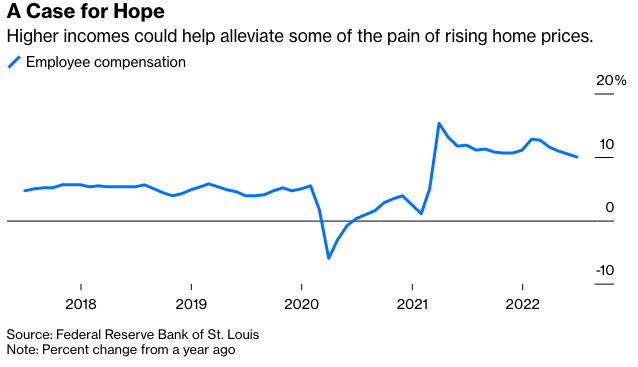The housing market has been searching for balance ever since mortgage rates rose above 5% at the end of April. Demand has fallen, and in response, homebuilders have cut back on housing starts. The torrid price appreciation of the past two years has ground to a halt, with the June S&P CoreLogic Case-Shiller index showing home prices grew at the slowest rate in two years.
In his speech at the Jackson Hole Economic Symposium last week, Federal Reserve Chairman Jerome Powell presented an economic outlook that suggests interest rates will be elevated for a sustained period of time, dashing the hopes that a pivot in monetary policy could lead to lower mortgage rates in 2023. Instead, the path to more normalized levels of housing market activity will depend on gains in worker incomes.
The tricky part about assessing the reasons for the plunge in buyer activity since April is that it’s due to both reduced affordability—a function of home prices and mortgage rates—as well as skittish homebuyer sentiment. That skittishness was particularly acute in June, when fears of inflation and recession reached a fever pitch.
In their quarterly earnings conference call last week, the luxury homebuilder Toll Brothers spoke to the latter dynamic, noting that traffic to their website and communities plunged in June. But Toll decided not to meaningfully increase buyer incentives, feeling that buyers had decided to take a pause to assess the state of the economy and housing market, and modest incentives wouldn’t lead to increased sales. Traffic has improved in July and August, which has made them more willing to offer incentives since they think it’s now more likely to lead to an improvement in transactions.
In a chart of Las Vegas weekly sales per subdivision, Zonda chief economist Ali Wolf last week showed that the same summer pattern has occurred there, where there was a big plunge in activity through early July, with a modest improvement over the past several weeks as buyers tiptoe back to the market.
An improvement in buyer psychology is helpful, but what’s really needed is improved affordability, and the question is how we get that. Meaningfully lower mortgage rates don’t seem to be on the table right now given the Fed’s policy stance. And while home prices have declined in some markets, emerging trends in the data suggest that sellers would rather hold onto their homes for now than cut prices a lot from these levels, which has led to new listings declining after a meaningful rise this spring and early summer.
That leaves rising incomes as the best hope for the housing market right now. The July personal income data released last week showed that wages and salaries grew 0.8% in July, or 10% on a year-over-year basis, as job and wage growth both remain strong. Presumably this will slow in the months to come as rising interest rates cool the labor market along with the economy. But that will take some time, and the wage growth that will have occurred between the first half of 2022 and the first half of 2023 will allow buyers to better handle higher mortgage rates next year even if home prices don’t fall.

Consider the following: The monthly payment on a $400,000 house with a 20% down payment and a 5% mortgage rate is around $2,200. At a 5.5% mortgage rate it’s around $2,300 per month, or an increase of 4.5%. Wage growth for workers has been running at a pace somewhat above 5% for a while now, suggesting that if 5% mortgage rates were the “speed limit” for the housing market this spring, that speed limit could be 5.5% by next spring as higher incomes give workers the ability to handle higher mortgage rates. And that doesn’t account for the hundreds of thousands of jobs the U.S. economy continues to add every month, with 1.3 million jobs added since April, when the housing market began to buckle under the weight of higher mortgage rates.
It’s possible the housing market could be in for even more negative surprises by the time we hit next year’s spring home-buying season—maybe we’re looking at 6% mortgage rates by then, or a deterioration in the labor market would negate the rising worker income story. But the environment we’ve experienced over the past few months—continued strong job and wage growth, with mortgage rates hovering in a range of 5.25% to 5.50%—if sustained, will allow the housing market to claw out of its hole. It won’t necessarily restore boom conditions, but it should make the housing market feel normal sooner rather than later.
Conor Sen is a Bloomberg Opinion columnist. He is founder of Peachtree Creek Investments and may have a stake in the areas he writes about.








